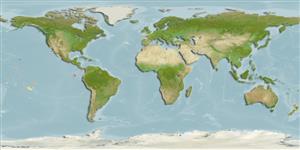Common names from other countries
Environment: milieu / climate zone / depth range / distribution range
Ecología
; salobre; rango de profundidad 1 - 2 m (Ref. 101353). Temperate
Distribución
Países | Áreas FAO | Ecosistemas | Ocurrencias, apariciones | Introducciones
Eastern Central Pacific and Northeast Atlantic: Mexico, Panama and UK.
Length at first maturity / Tamaño / Peso / Age
Maturity: Lm ? range ? - ? cm Max length : 25.0 cm SHL macho / no sexado; (Ref. 101485)
Depth range is based on occurrence in Mexico (Ref. 101353); to be replaced with a better reference. Mostly inhabits the intertidal zone (Ref. 106881). Found in mangroves (Refs. 101351, 106881), estuaries and coastal lagoons associated with mangrove roots (Ref. 106881). Eurythermal and euryhaline (Ref. 106881).
Life cycle and mating behavior
Madurez | Reproducción | Puesta | Huevos | Fecundidad | Larva
Members of the class Bivalvia are mostly gonochoric, some are protandric hermaphrodites. Life cycle: Embryos develop into free-swimming trocophore larvae, succeeded by the bivalve veliger, resembling a miniature clam.
The British Flora and Fauna Database. 2007. (Ref. 8593)
IUCN Red List Status (Ref. 130435)
CITES status (Ref. 108899)
Not Evaluated
Not Evaluated
Human uses
Pesquerías: comercial
FAO - Acuicultura: producción; | FishSource | Sea Around Us
Herramientas
Fuentes de Internet
Estimates based on models
Preferred temperature
(Ref.
115969): 12.4 - 26.9, mean 19 (based on 123 cells).
Resiliencia
Alto, población duplicada en un tiempo mínimo inferior a 15 meses (K=1.08-1.1).
